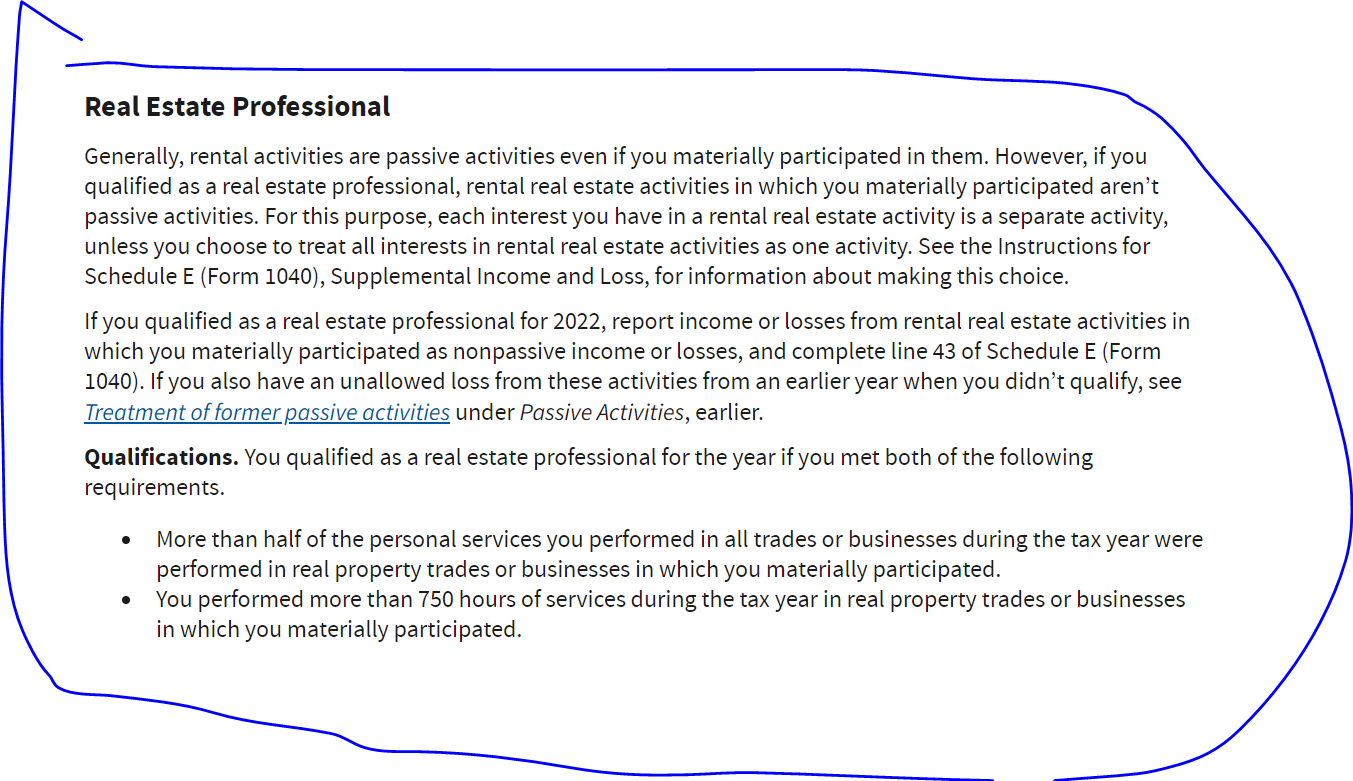- Community
- Topics
- Community
- :
- Discussions
- :
- Taxes
- :
- Business & farm
- :
- If the K1 I received shows a loss, do I need to enter it in this years tax return or wait until I sell the units or get positive activity in a future year?

Do you have an Intuit account?
You'll need to sign in or create an account to connect with an expert.
- Mark as New
- Bookmark
- Subscribe
- Subscribe to RSS Feed
- Permalink
- Report Inappropriate Content
If the K1 I received shows a loss, do I need to enter it in this years tax return or wait until I sell the units or get positive activity in a future year?
Hi JulieS for this very informative reply. For my third question, I am asking if you have a net gain from Schedule D (rental property sale net gain minus stock losses). Can the K-1 passive losses from 2022 and also K-1 passive losses carryforward from other S corporation partnership investments be used to further offset the net gain from Schedule D? Thanks.
- Mark as New
- Bookmark
- Subscribe
- Subscribe to RSS Feed
- Permalink
- Report Inappropriate Content
If the K1 I received shows a loss, do I need to enter it in this years tax return or wait until I sell the units or get positive activity in a future year?
The answer is yes, Passive activity losses are offset against passive activity gains. In your situation, both the rental property sale , the stock losses are considered passive activity. See HERE as to what constitutes passive activity


Remember, in your case, the rental activity would have to be considered passive. To meet those qualifications, see here

See also HERE that passive only losses that are "greater" than the income from passive activity are disallowed for the current year. But up untill that point, it is allowed.
**Mark the post that answers your question by clicking on "Mark as Best Answer"
- Mark as New
- Bookmark
- Subscribe
- Subscribe to RSS Feed
- Permalink
- Report Inappropriate Content
If the K1 I received shows a loss, do I need to enter it in this years tax return or wait until I sell the units or get positive activity in a future year?
Hi Abraham T:
If as you said, rental property sale is considered as passive activity, does it mean the gain from the rental property sale is considered as passive gain and can be offset by passive loss?
If so, the next question in the year when the rental property is sold, if you have suspended passive losses carryover from other real estate partnerships (different investments from this rental property and these different passive real estate investments have not been sold), can you use these suspended passive losses to offset the gain from this rental property sale? Shouldn't the answer be no?
- Mark as New
- Bookmark
- Subscribe
- Subscribe to RSS Feed
- Permalink
- Report Inappropriate Content
If the K1 I received shows a loss, do I need to enter it in this years tax return or wait until I sell the units or get positive activity in a future year?
Yes, your first question. The gain from the sale of the property is considered passive. Gains on the sale, exchange, or other disposition of property used in an activity is characterized in the same way as the activity itself. If the activity is passive, the gain is passive. This also applies to an interest held through a pass-through entity, (e.g., a partnership or S corporation). Therefore, losses from passive activities can offset this income.
Yes, you can deduct your suspended losses from total profit when you sell your rental property, as long as you meet certain IRS rules.
- First, when selling your rental property, you must sell “substantially all” of the rental activity. For example, if you own a single rental property and sell it, you have disposed of your entire interest and can take the full deduction.
- You must trigger a tax event, meaning that you must sell your interest for value in a fully taxable transaction
- And you must sell your interest to an unrelated third party, no family or close affiliates
However, if you have more than one rental property, deducting your suspended losses depends on how your properties are structured.
You may also offset other PAL carryovers by following the steps below:
When you sell the property you must follow these steps:
- Apply current and suspended losses against your gains from this sale. Or, if you took a loss on this sale, you can add this loss to your total current and suspended losses from the activity
- If you have remaining gains from selling your passive activity after step one, you can apply any losses from any other passive activities.
- If you still have losses after step one, meaning that if your passive losses exceeded the sale value of your passive activity, you can first apply those losses to any other passive gains you had this year.
**Mark the post that answers your question by clicking on "Mark as Best Answer"
- Mark as New
- Bookmark
- Subscribe
- Subscribe to RSS Feed
- Permalink
- Report Inappropriate Content
If the K1 I received shows a loss, do I need to enter it in this years tax return or wait until I sell the units or get positive activity in a future year?
When one sells a rental property that followed a straight line 27.5 year depreciation schedule, the net gain should be reported on Form 4797 - it will likely be categorized as a 1250 property. The net gain should be transferred to Schedule D. If the rental property is in service for a few years prior to sale, the net sale gain should be a long term capital gain. The tax should be calculated based on capital gain tax rate. The depreciation recapture should be calculated at the depreciation recapture tax rate. these should all be included in the total amount shown on Line 16 on Form 1040. The suspended passive losses on this rental properties over the years should be reported on Schedule 1 and the Schedule 1 result should then be transferred to Line 8 on Form 1040.
Is this summary correct?
However, several experts provided conflicting answers regarding how the gain from the sale of a rental property can or cannot be offset by suspended K-1 passive losses from other partnerships (unrelated to this rental property). If the net gain from the rental property sale is included as a long term capital gain on Schedule D, the net gain is allowed to be offset by stock losses. If so, how can the net gain from the rental property sale is also offset by the suspended K-1 passive losses from other partnerships (unrelated to this rental property) on Schedule E? It does not make any sense to offset the same gain twice - one on Schedule D and another one on Schedule E.
- Mark as New
- Bookmark
- Subscribe
- Subscribe to RSS Feed
- Permalink
- Report Inappropriate Content
If the K1 I received shows a loss, do I need to enter it in this years tax return or wait until I sell the units or get positive activity in a future year?
If the rental real estate is a passive activity. See here for the qualifications

then the gain on from the Sch D will be considered a passive activity gain and will be offset by suspended passive losses which will show up on pg. 2 of your Schedule E. So, it won't show up twice. The gain will show up on Sch D and the loss will show up on Sch E and that's how they will offset each other.
**Mark the post that answers your question by clicking on "Mark as Best Answer"
- Mark as New
- Bookmark
- Subscribe
- Subscribe to RSS Feed
- Permalink
- Report Inappropriate Content
If the K1 I received shows a loss, do I need to enter it in this years tax return or wait until I sell the units or get positive activity in a future year?
Thanks AbrahamT. The question is then, assuming the real sale is a passive activity, where and how to enter the selling a rental property with a net gain 165k, rental income loss of $1200 suspended rental income passive losses from past years of 13k, current year of pass through total losses from other unrelated partnerships on K-1’s of 15k, and suspended passive losses from these other unrelated partnerships on K-1’s of 300k, and finally stock losses of 50k, in this example? How does TurboTax communicate between Form 4797, Form 8252, Schedule D, Schedule E and Schedule 1 in a logical sequence stepwise? Thanks
- Mark as New
- Bookmark
- Subscribe
- Subscribe to RSS Feed
- Permalink
- Report Inappropriate Content
If the K1 I received shows a loss, do I need to enter it in this years tax return or wait until I sell the units or get positive activity in a future year?
I would like to take a deeper look at this. However, I need a diagnostic file which is a copy of your tax return that has all of your personal information removed. You can send one to us by following the
directions below:
TurboTax Online:
1. Sign into your online account.
2. Locate the Tax Tools on the left-hand side of the screen.
3. A drop-down will appear. Select Tools
4. On the pop-up screen, click on “Share my file with agent.”
5. This will generate a message that a diagnostic file gets sanitized and transmitted to us.
6. Please provide the Token number in a reply to this post.
TurboTax Desktop/Download
1. Open your return.
2. Click the Online tab in the black bar across the top of TurboTax andselect “Send Tax File to Agent”
3. This will generate a message that a diagnostic copy will be created. Click on OK and the tax file will be
sanitized and transmitted to us.
4. Please provide the Token Number
**Mark the post that answers your question by clicking on "Mark as Best Answer"
- « Previous
- Next »
Still have questions?
Questions are answered within a few hours on average.
Post a Question*Must create login to post
Unlock tailored help options in your account.
Get more help
Ask questions and learn more about your taxes and finances.
Related Content

jkgvharden
Level 3

Lee-K
Level 2

Matas
New Member

tarti
New Member

BlueHen85
Level 1

